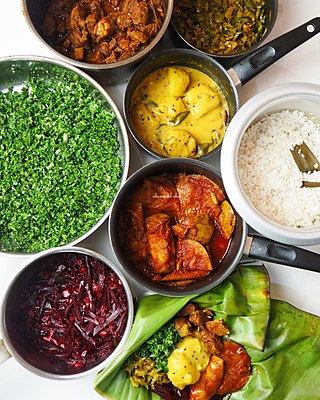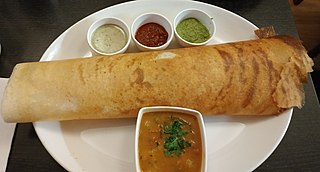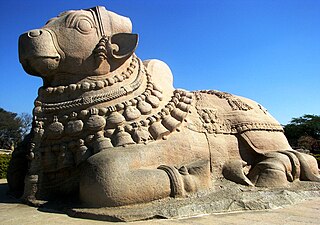
Thai cuisine is the national cuisine of Thailand.
Indian cuisine consists of a variety of regional and traditional cuisines native to the Indian subcontinent. Given the diversity in soil, climate, culture, ethnic groups, and occupations, these cuisines vary substantially and use locally available spices, herbs, vegetables, and fruits.

Pakistani cuisine can be characterized as a blend of regional cooking styles and flavours from across South, Central and Western Asia. Pakistani cuisine is influenced by Persian, Indian, and Arab cuisine. The cuisine of Pakistan also maintains certain Mughal influences within its recipes and cooking techniques. Pakistan's ethnic and cultural diversity, diverse climates, geographical environments, and availability of different produce lead to diverse regional cuisines.

Sri Lankan cuisine is known for its particular combinations of herbs, spices, fish, vegetables, rices, and fruits. The cuisine is highly centered around many varieties of rice, as well as coconut which is a ubiquitous plant throughout the country. Seafood also plays a significant role in the cuisine, be it fresh fish or preserved fish. As a country that was a hub in the historic oceanic silk road, contact with foreign traders brought new food items and cultural influences in addition to the local traditions of the country's ethnic groups, all of which have helped shape Sri Lankan cuisine. Influences from Indian, Indonesian and Dutch cuisines are most evident with Sri Lankan cuisine sharing close ties to other neighbouring South and Southeast Asian cuisines.

Rajasthani cuisine is the traditional cuisine of the Rajasthan state in north-west India. It was influenced by various factors like the warlike lifestyles of its inhabitants, the availability of ingredients in an arid region and by Hindu temple traditions of sampradayas like Pushtimarg and Ramanandi. Food that could last for several days and could be eaten without heating was preferred.
Malvani cuisine is the standard cuisine of the South Konkan region of the Indian states of Maharashtra and Goa. Although Malvani cuisine is predominantly non-vegetarian, there are many vegetarian dishes. Although it is an independent cuisine, it overlaps Maharashtrian cuisine and Goan cuisine. Malvan is a town in the Sindhudurg district on the west coast of Maharashtra.
Maharashtrian or Marathicuisine is the cuisine of the Marathi people from the Indian state of Maharashtra. It has distinctive attributes, while sharing much with other Indian cuisines. Traditionally, Maharashtrians have considered their food to be more austere than others.

Gujarati cuisine is the cuisine of the Indian state of Gujarat. The typical Gujarati thali consists of rotli, dal or curry, rice, and shaak. The thali will also include preparations made from pulses or whole beans such as moong, black eyed beans etc., a snack item (farsaan) like dhokla, pathra, samosa, fafda, etc. and a sweet (mishthaan) like mohanthal, jalebi, sevaiya etc.

Indian breads are a wide variety of flatbreads and crêpes which are an integral part of Indian cuisine. Their variation reflects the diversity of Indian culture and food habits.
Bhojpuri cuisine is a style of food preparation common among the Bhojpuri people of Bihar, Jharkhand and eastern Uttar Pradesh in India, and also the Terai region of Nepal. Bhojpuri foods are mostly mild and tend to be less hot in terms of spices used. The cuisine consists of both vegetable and meat dishes.
Konkani cuisine is the cuisine of the Saraswat Brahmins from the Konkan region on the western coast of India. Konkani cuisine differs within the Saraswat Brahmin subsects and within the Konkan-Canara region. Konkani cuisine originally hails from the Konkan region including Uttara Kannada, Udupi district, Dakshina Kannada, Damaon, and Goa, India. Konkani cuisine is popular served in many restaurants throughout the western coast of India, and especially in the cities of Bombay and Bangalore. Each variation has its unique flavour and makes uses of different vegetables and fruits available in the region. Konkani cuisine is usually pesco-vegetarian, except acharyas and purohits who follow a strictly saatvik vegetarian diet. According the Konkani folklore, fish, meats are regarded as sea vegetables. Historically, they have refrained from eating any terrestrial animals in general.

Javanese cuisine is the cuisine of Javanese people, a major ethnic group in Indonesia, more precisely the province of Central Java, Yogyakarta and East Java.

Padang dish or Minangkabau dish is the cuisine of the Minangkabau people of West Sumatra, Indonesia. It is among the most popular cuisines in Maritime Southeast Asia. It is known across Indonesia as Masakan Padang after Padang, the capital city of Western Sumatra province. It is served in restaurants mostly owned by perantauan (migrating) Minangkabau people in Indonesian cities. Padang food is ubiquitous in Indonesian cities and is popular in neighboring Malaysia and Singapore.

Kuḻambu, is a tamarind-based stew in Tamil cuisine popular in Tamil Nadu and Sri Lanka that can include a variety of meat, vegetables, and in some cases, dal.

Chadian cuisine is the cooking traditions, practices, foods and dishes associated with the Republic of Chad. Chadians use a medium variety of grains, vegetables, fruits and meats. Commonly consumed grains include millet, sorghum, and rice as staple foods. Commonly eaten vegetables include okra and cassava. A variety of fruits are also eaten. Meats include mutton, chicken, pork, goat, fish, lamb and beef. The day's main meal is typically consumed in the evening on a large communal plate, with men and women usually eating in separate areas. This meal is typically served on the ground upon a mat, with people sitting and eating around it.

Andhra cuisine, culturally known as Telugu cuisine, is a cuisine of India native to the state of Andhra Pradesh and is the culinary style of Telugu people. It is generally known for its tangy, hot, and spicy taste.

Malaysian Indian cuisine, or the cooking of the ethnic Indian communities in Malaysia, consists of adaptations of authentic dishes from India, as well as original creations inspired by the diverse food culture of Malaysia. Because the vast majority of Malaysia's Indian community are of South Indian descent, and are mostly ethnic Tamils who are descendants of immigrants from a historical region which consists of the modern Indian state of Tamil Nadu and Sri Lanka's Northern Province, much of Malaysian Indian cuisine is predominantly South Indian inspired in character and taste. A typical Malaysian Indian dish is likely to be redolent with curry leaves, whole and powdered spice, and contains fresh coconut in various forms. Ghee is still widely used for cooking, although vegetable oils and refined palm oils are now commonplace in home kitchens. Before a meal it is customary to wash hands as cutlery is often not used while eating, with the exception of a serving spoon for each respective dish.

Sarva pindi is a savory, circular-shaped pancake made from rice flour and peanuts in Telangana, India. In the Warangal district, the item is known as "tappala chekka", while in Siddipet it is also known as "sarva pindi". "Ganju" means utensil or a round shaped bowl and "pindi" means flour in Telugu language. So, the phrase "Ganju Pindi" can be described as rice flour that is made like atta flour and stick to the round shaped pan. In Warangal, the dish is known as "ginnappa". The village Bollepally in Warangal district is particularly famous for ginnappa, as the story about ginnappa first originated from the Challa Anasurya house in the village. Years ago, Anasurya was feeling very hungry in rainy season, but desired a new dish with less oil. As she had only rice flour in her home at the time, this led to the creation of the sarva pindi snack. She began to sell some in Bollepally village, Telangana district. Eventually the snack became popular throughout Telangana.

Betawi cuisine is rich, diverse and eclectic, in part because the Betawi people that create them were composed from numbers of regional immigrants that came from various places in the Indonesian archipelago, as well as Chinese, Indian, Arab, and European traders, visitors and immigrants that were attracted to the port city of Batavia since centuries ago.

Acehnese cuisine is the cuisine of the Acehnese people of Aceh in Sumatra, Indonesia. This cuisine is popular and widely known in Indonesia. Arab, Persian, and Indian traders influenced food culture in Aceh although flavours have substantially changed their original forms. The spices combined in Acehnese cuisine are commonly found in Indian and Arab cuisine, such as ginger, pepper, coriander, cumin, cloves, cinnamon, cardamom, and fennel.


















